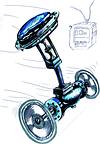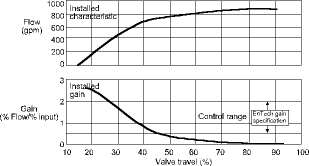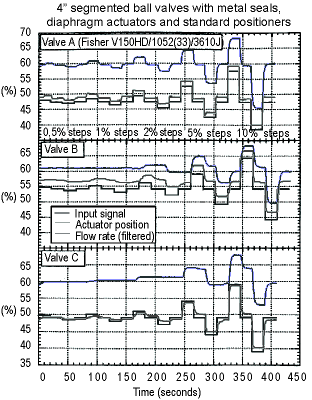

The style of valve used and the sizing of the valve can have a large impact on the performance of the control valve assembly in the system. While a valve must be of sufficient size to pass the required flow under all possible contingencies, a valve that is too large for the application is a detriment to process optimisation.
Flow capacity of the valve is also related to the style of valve through the inherent characteristic of the valve. The inherent characteristic (as discussed in the first article of this series) is the relationship between the valve flow capacity and the valve travel when the differential pressure drop across the valve is held constant.
Typically, these characteristics are plotted on a curve where the horizontal axis is labelled in percent travel although the vertical axis is labelled as percent flow (or CV). Since valve flow is a function of both the valve travel and the pressure drop across the valve, it is traditional to conduct inherent valve characteristic tests at a constant pressure drop. This is not a normal situation in practice, but it provides a systematic way of comparing one valve characteristic design to another.
Under the specific conditions of constant pressure drop, the valve flow becomes only a function of the valve travel and the inherent design of the valve trim. These characteristics are called the inherent flow characteristic of the valve. Typical valve characteristics conducted in this manner are named linear, equal percentage, and quick opening.
The ratio of the incremental change in valve flow (output) to the corresponding increment of valve travel (input) which caused the flow change is defined as the valve gain; that is:
Inherent valve gain = (change in flow)/(change in travel) = slope of the inherent characteristic curve
The linear characteristic has a constant inherent valve gain throughout its range, and the quick-opening characteristic has an inherent valve gain that is the greatest at the lower end of the travel range. The greatest inherent valve gain for the equal percentage valve is at the largest valve opening.
Inherent valve characteristic is an inherent function of the valve flow passage geometry and does not change as long as the pressure drop is held constant. Many valve designs, particularly rotary ball valves, butterfly valves, and eccentric plug valves, have inherent characteristics, which cannot be easily changed; however, most globe valves have a selection of valve cages or plugs that can be interchanged to modify the inherent flow characteristic.
Knowledge of the inherent valve characteristic is useful, but the more important characteristic for purposes of process optimisation is the installed flow characteristic of the entire process, including the valve and all other equipment in the loop. The installed flow characteristic is defined as the relationship between the flow through the valve and the valve assembly input when the valve is installed in a specific system, and the pressure drop across the valve is allowed to change naturally, rather than being held constant. An illustration of such an installed flow characteristic is shown in the upper curve of Figure 1. The flow in this figure is related to the more familiar valve travel rather than valve assembly input.

Installed gain, shown in the lower curve of Figure 1, is a plot of the slope of the upper curve at each point. Installed flow characteristic curves such as this can be obtained under laboratory conditions by lacing the entire loop in operation at some nominal set point and with no load disturbances. The loop is placed in manual operation, and the flow is then measured and recorded as the input to the control valve assembly is manually driven through its full travel range. A plot of the results is the installed flow characteristic curve shown in the upper part of Figure 1. The slope of this flow curve is then evaluated at each point on the curve and plotted as the installed gain as shown in the lower part of Figure 1.
Field measurements of the installed process gain can also be made at a single operating point using open-loop step tests (Figure 2). The installed process gain at any operating condition is simply the ratio of the percent change in output (flow): the percent change in valve assembly input signal.

The reason for characterising inherent valve gain through various valve trim designs is to provide compensation for other gain changes in the control loop. The end goal is to maintain a loop gain, which is reasonably uniform over the entire operating range, to maintain a relatively linear installed flow characteristic for the process. Because of the way it is measured, as defined above, the installed flow characteristic and installed gain represented in Figure 1 are really the installed gain and flow characteristic for the entire process.
Typically, the gain of the unit being controlled changes with flow. For example, the gain of a pressure vessel tends to decrease with throughput. In this case, the process control engineer would then likely want to use an equal percentage valve that has an increasing gain with flow. Ideally, these two inverse relationships should balance out to provide a more linear installed flow characteristic for the entire process.
Theoretically, a loop has been tuned for optimum performance at some set point flow condition. As the flow varies about that set point, it is desirable to keep the loop gain as constant as possible to maintain optimum performance. If the loop gain change due to the inherent valve characteristic does not exactly compensate for the changing gain of the unit being controlled, then there will be a variation in the loop gain due to variation in the installed process gain. As a result, process optimisation becomes more difficult. There is also a danger that the loop gain might change enough to cause instability, limit cycling, or other dynamic difficulties.
Loop gain should not vary more than a 4:1 ratio; otherwise, the dynamic performance of the loop suffers unacceptably. There is nothing magic about this specific ratio; it is simply one which many control practitioners agree produces an acceptable range of gain margins in most process control loops.
This guideline forms the basis for the following EnTech gain limit specification (For Control Valve Dynamic Specification, Version 2.1, March 1994, EnTech Control Inc, Toronto, Ontario, Canada):
Loop process gain = 1,0 (% of transmitter span)/(% controller output)
Nominal range: 0,5 to 2,0 (note 4:1 ratio)
Note that this definition of the loop process includes all the devices in the loop configuration except the controller. In other words, the product of the gains of such devices as the control valve assembly, the heat exchanger, pressure vessel, or other system being controlled, the pump, the transmitter, etc. is the process gain. Because the valve is part of the loop process as defined here, it is important to select a valve style and size that will produce an installed flow characteristic that is sufficiently linear to stay within the specified gain limits over the operating range of the system. If too much gain variation occurs in the control valve itself, it leaves less flexibility in adjusting the controller. It is good practice to keep as much of the loop gain in the controller as possible.
Although the 4:1 ratio of gain change in the loop is widely accepted, not everyone agrees with the 0,5 to 2,0 gain limits. Some industry experts have made a case for using loop process gain limits from 0,2 to 0,8, which is still a 4:1 ratio. The potential danger inherent in using this reduced gain range is that the low end of the gain range could result in large valve swings during normal operation. It is good operating practice to keep valve swings below about 5%. However, there is also a danger in letting the gain get too large. The loop can become oscillatory or even unstable if the loop gain gets too high at some point in the travel. To ensure good dynamic performance and loop stability over a wide range of operating conditions, industry experts recommend that loop equipment be engineered so the process gain remains within the range of 0,5 to 2,0.
The next article in this series will continue looking at the factors in process control loop that have an influence on the control response characteristic.
| Tel: | +27 11 249 6700 |
| Email: | [email protected] |
| www: | www.acs-autocon.com |
| Articles: | More information and articles about Automation Control Solutions |

© Technews Publishing (Pty) Ltd | All Rights Reserved